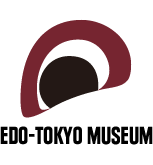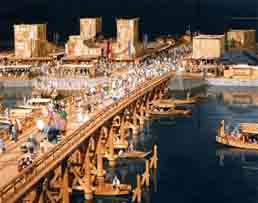

Overview
The Tokyo Metropolitan Edo-Tokyo Museum opened in March 1993 as a place that would allow us to look back on the history and culture of Edo-Tokyo, and consider the future of the city and its people. Housed in a unique building designed by Kikutake Kiyonori, the museum has been one of Tokyo’s most well-known cultural facilities since its opening, introducing works primarily from the approximately 400-year period from when Tokugawa Ieyasu took up residence in Edo to the present day, through precious real-life materials, reconstructed models, and interactive exhibits.
Basic Policy
The Tokyo Metropolitan Edo-Tokyo Museum aspires to be a cultural facility that offers high quality programs modeled on “iki,” an aesthetic ideal distinct to Edo, and, at the same time, “nigiwai (bustling)” with many visitors to this museum specializing in the history of the city. To this end, we will readapt this concept of “iki and nigiwai” to meet contemporary contexts on which the Museum’s basic administrative policy shall rest.
We will pass on to future generations the history and culture of Edo-Tokyo through the core activities of the Museum, namely, the collection of related materials, the holding of exhibitions, and the preservation of a collection of about 590,000 items. We will ensure that the Tokyo population at large will benefit from the outcomes of our studies and research, and we will hold diverse outreach programs. Furthermore, we will encourage people-to-people exchanges among people visiting from other parts of Japan and overseas, identifying the Edo-Tokyo Museum as a center of tourism and regional promotion.
Greetings from the Director
I became the Director of the Edo-Tokyo Museum in 2016.
Many years have passed since I was first involved with the museum. When the Edo-Tokyo Museum and Edo-Tokyo Open-Air Architectural Museum were established, I was in charge of exhibitions at the former, and head of collections at the latter. I was one of the youngest museum staff members at that time. Although I did not work directly with the first director, Mr. Kouta Kodama, the second and third directors, Mr. Shinzo Ogi and Mr. Makoto Takeuchi, were my personal mentors. Ever since these early experiences, I have been involved in the management of the museum as a member of various committees.
Although the Edo-Tokyo Museum does not have a long history, inevitably there have been many unexpected twists and turns. The efforts and collected wisdom of both internal and external stakeholders have made the museum what it is today. I firmly believe this could not have been realized without Mr. Takeuchi’s administration, and I sincerely appreciate his 18 years of dedicated service as Director.
We have recently completed extensive renovations of our museum’s permanent exhibition space, and have steadily and consistently mounted successful special exhibitions. As a result of these efforts, the Edo-Tokyo Museum has established itself as the foremost historical museum of Tokyo in both name and content. My mission is to maintain this course.
We would like to thank you for your continued support and encouragement.
Currently, the museum is closed for an extended period of time to undergo major renovations, including a complete overhaul of equipment and facilities, due to the aging deterioration of the entire facility and its equipment. During this closure, museum staff will continue to engage in activities outside the museum, both in Japan and abroad.
We are preparing for our scheduled reopening in the spring of 2026 so that everyone can enjoy visiting this historical museum in Tokyo Metropolis.

Tokyo Metropolitan Edo-Tokyo Museum
Director Terunobu Fujimori
Logo

The Edo-Tokyo Museum’s logo was modeled after the left eye of the famous ukiyo-e print of a kabuki actor, entitled, “Ichikawa Ebizo no Takemura Sadanoshin (Ichikawa Ebizo as Takemura Sadanoshin),” which was painted by the so-called mysterious ukiyo-e painter of the Edo period, Toshusai Sharaku. The intense cross-eye expression of the mie pose is intended to represent the fascination and curiosity of the visitors to the museum. This logo – this gaze from the distant Edo period – seems to be watching over Tokyo, both in the present day and into the future (Designer: Koichi Sato).

Official mascot of the Edo-Tokyo Museum, Gibo-chan
This official mascot was selected through a contest in March 2003 on the occasion of the tenth anniversary of the Edo-Tokyo Museum, with a view to making the museum more accessible to the people in Tokyo. The mascot was modeled after the newel post of the railing of the Nihonbashi Bridge attached with an ornament known as “giboshi” (in the shape of the bulbous flower of the onion). The bridge is displayed in the permanent exhibition.
30th Anniversary a History
General Guide
◆What is the Edo-Tokyo Museum?
| The Edo-Tokyo Museum is a museum of Tokyo urban history, which exhibits the history, life, and culture of the city from the 1600s to today. Its permanent exhibition area on the 5th to 6th floors covers a vast space of almost 100,000 square foot. |
 Edo-Tokyo Museum exterior |
◆What is “Edo”?
| More than 400 years have passed since warlord Tokugawa Ieyasu established his government in Edo, located in today’s Tokyo area. By the early 18th century, Edo had become one of the world’s largest metropolises, with a population of about one million people. By the late 18th century, its own distinctive culture had flourished, and it had become Japan’s de facto capital, where people, manufactures, and information converged from all over the country. |

“New Year’s Day in front of Mitsui Echigoya in Suruga-chō,” 19th century |
◆Culture of the Edo people
Edo was a lively center from which spread the latest trends and cultural products, such as kabuki theatre, popular and religious festivals, fashion, and ukiyo-e woodblock prints. In time it became a major destination that attracted visitors from all over the country. Edo townspeople adopted these trends and cultural products, making Edo culture more sophisticated.
◆Edo culture and Europe in 19th century
|
Exported Japanese ceramics and lacquerware were highly appreciated and met the taste of the European upper class. Ukiyo-e woodblock prints, which had been introduced to Europe in the mid-19th century, influenced Impressionist painters. |
 Katsushika Hokusai, “The Great Wave off Kanagawa,” 19th century |
◆From Edo to Tokyo
The restoration of imperial power in 1868 (Meiji Restoration) brought to an end the military regime established by the Tokugawa family in Edo two and a half centuries before. The capital was transferred from Kyoto to Edo, which was renamed Tokyo (“Eastern capital”), while Edo Castle, former residence of the Tokugawa chieftains, became the new imperial palace.
◆Learning about the culture & history of Tokyo
|
The permanent exhibition area features life-size models of the Nihonbashi bridge and houses of the Edo townsmen. Several finely crafted dioramas re-create in great detail the architecture and lifestyles peculiar to each period. Hands-on exhibits display tools used by Edo merchants, Edo firefighters’ equipment, a traditional palanquin used by Edo-period feudal lords, and other artifacts. Through the museum’s exhibits and abundant original historical material, visitors can learn about the history of Tokyo regardless of their age or nationality. |
 (Diorama) West side of Ryōgoku Bridge |
◆For International Visitors
Volunteer guides offer tours of the permanent exhibition areas free of charge, from 10:00 a.m. to 3:00 p.m. Tours in Japanese, English, Chinese, Korean, French, Spanish, German and Italian are available, depending on the availability of volunteers who speak these languages. Visitors can either request a tour on the same day or make a reservation by phone prior to a visit. For more information, please contact the Volunteer Guide Reservation Desk (+81-3-3626-9974).
Audio guides for the permanent exhibitions are available free of charge (note: a JPY1,000 deposit is required) in Japanese, English, Chinese (Simplified), Chinese (Traditional), Korean, French, Spanish, German, Italian, Russian and Thai. They can be borrowed on 6th-floor Audio Guide Rental Counter (return to 5th-floor Audio Guide Return Counter). The permanent exhibition area features numerous touchscreen displays with explanations in Korean, Chinese (Simplified), Chinese (Traditional), Spanish, Dutch, French, Italian, Russian, Portuguese, Malay and Thai.
◆Walking Around the Museum
The nearest train station to the museum is Ryōgoku on the JR Line or Ryōgoku on the Toei Ōedo Subway Line. The Ryōgoku area is located less than a ten-minute ride from many popular tourist spots such as Tokyo, Ueno, Asakusa, and Akihabara. The Sumida River is minutes away from the museum and you can reach Asakusa by ferry from there.
◆Edo-Tokyo Open Air Architectural Museum
| The Edo-Tokyo Open Air Architectural Museum, a branch of the Edo-Tokyo Museum System, is located in Koganei Park. It houses 30 historic buildings that are representative of Japanese architecture from the 17th century to the 20th century. These buildings were moved to the museum, where they have been carefully restored and preserved for display to the public. Visitors can enter and walk around several buildings and experience how their original residents used to live. |
 Edo-Tokyo Open Air Architectural Museum |







